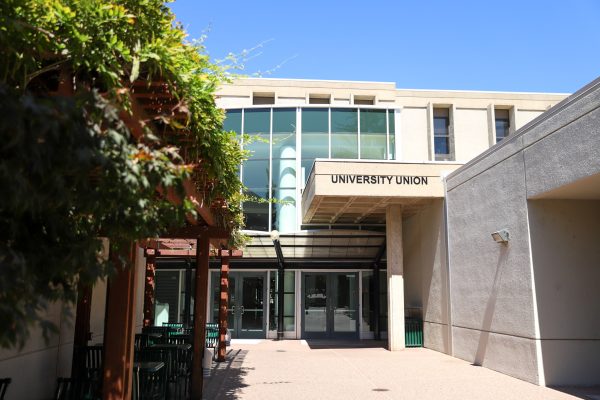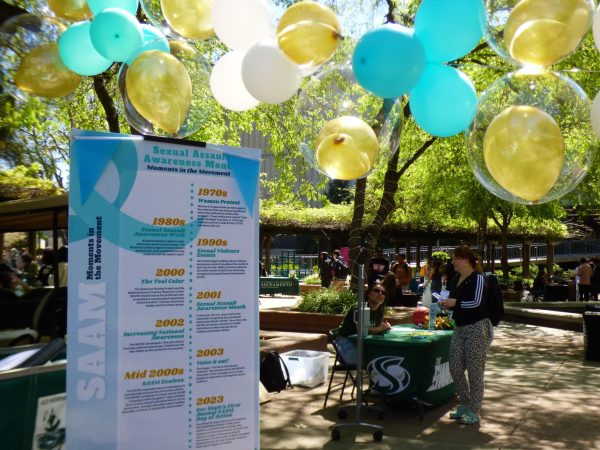Competitive Robotics club members battle it out at the Engineering Expo
March 11, 2014
Minutes before a tournament began, Sacramento State Competitive Robotics members can be seen preparing robots by tightening screws, examining movements of motors or testing communication between robot and remote controller.
The Engineering Expo Sunday featured eight 1-pound robots that were deployed into a glass encased arena to battle, using various weapons and techniques, including spinning, saw blades, or using body weight to ram opponents against the glass walls.
“It is a nice way for students to be able to take some of their ideas and knowledge about science and mix it in freely with creativity, and not have to worry about harsh deadlines, grades and how they perform against their peers,” said Daniel Fraga, mechanical engineering graduate student. “When you take that pressure away from students, it is amazing what they can come up with.”
Sophomore mechanical engineer David Sarver took first place. His robot, Jimmy No. 2, used a spinning technique that attacked by cutting into its opponents with blades.
Although the matches last three minutes or less, the planning phase for the robots begins months in advance.
For junior electrical engineering major Nitish Khazane, the brainstorming phase began after the last robot tournament fall 2013. It took three robot design drafts before he was inspired by a drill bit he found laying around in the shop.
“Think of a scorpion,” Khazane said while describing his robot. “With a tail end that can rotate on a rod. At the end of the scorpion tail, I have a drill bit attached that will spin and lash out like a scorpion would.”
‘Scorpios’’ weapon is an offensive technique that seeks to capitalize on the exposed tops of robot rivals. Khazane began building the frame of the robot after winter break.
Khazane, also vice president for Competitive Robotics at Sac State, joined the club as a sophomore and has participated in the robot tournament every semester since. His accomplishments, he said, are in part to experienced club members whom have helped develop tool craftsmanship and club management.
“It was really through past leadership, than a specific class, that allowed me to be (confident) that I could build a bot,” Khazane said.
Khazane said an issue for robot competitors is having to fight against overheating.
“Some of the motors would overheat during a battle, killing the motor temporarily,” Khazane said. “The challenge is to let heat dissipate without compromising defense.”
Khazane said he is confident in this semester’s robot design.
“My bot stands a really good chance of dominating the competition,” Khazane said. “The advantage that I will try to exploit is attacking from above and targeting the structurally weaker points.”
The ant-weight tournament (1-pound bots) is a chance to hone skills for the regional competition in Los Angeles, hosted by the National Robotics League in April, where students will battle 15-pound robots, Khazane said.
Andrew Tschoepe, electrical engineering junior and project manager for Competitive Robotics took second place in the tournament. His wedge-shaped robot used its body to ram opponents into the surrounding glass.
Tschoepe participated in the tournament last semester and said the way the weapon was mounted onto the frame of his robot caused it to cut into the frame as it spun. He also had issues with overheating and removed the extra paneling on his design this semester to combat the problem.
Tschoepe’s robot ‘The Surgeon,’ jousted this semester with a similar base design, but a different weapon strategy, he said.
“I attached the motors to the frame instead of creating its own chassis, and opened up the inside to create more airflow,” Tschoepe said.
Another challenge came from using two different types of motors, one to control the wheels, the other for the blade. This semester, his design included only one type of motor and he removed the blade altogether. A wedge-shaped aluminum sheet covering the rectangular base acted as a body slammer by scooting opponents towards the glass walls. His first opponent lost a wheel moving Tschoepe to the next match.
For Schoepe, the competition is about troubleshooting with a critical and creative approach, he said.
“What we found this semester is that it is easier to help each other out using a standardized model (for the robot’s frame),” Schoepe said.
He said since he has competed in the past, he did not draft a robot design on paper this semester.
“It’s not that big of a project,” Schoepe said. “Part of it is just having fun. It is something we do to showcase our efforts and it is also traditional for the club.”
This semester, the team experienced technical difficulties with interference from the receivers in the robots and the controllers.
“We are going to buy more receivers and transmitters and have them all matched up before the match,” Schoepe said. “That should reduce the interference.”
Fraga said these types of competitions improve students’ ability to manage time and money, and also work with a team.
“It lets you round out your skills,” Fraga said. “It lets you hone them a bit in an environment that fosters it. That is really what aids in professional skills, the self-driven desire to keep your skills sharp.”








































































































































